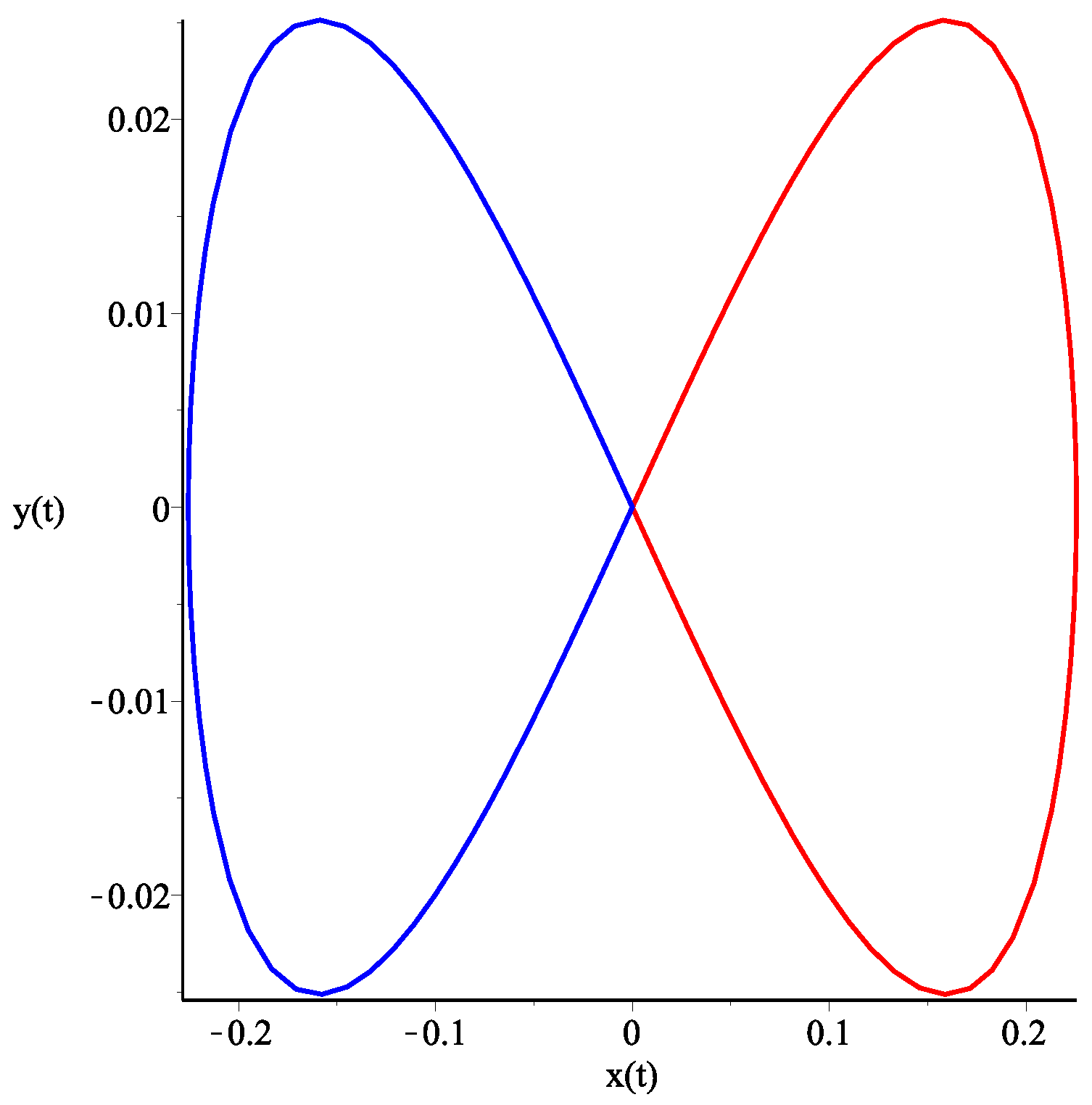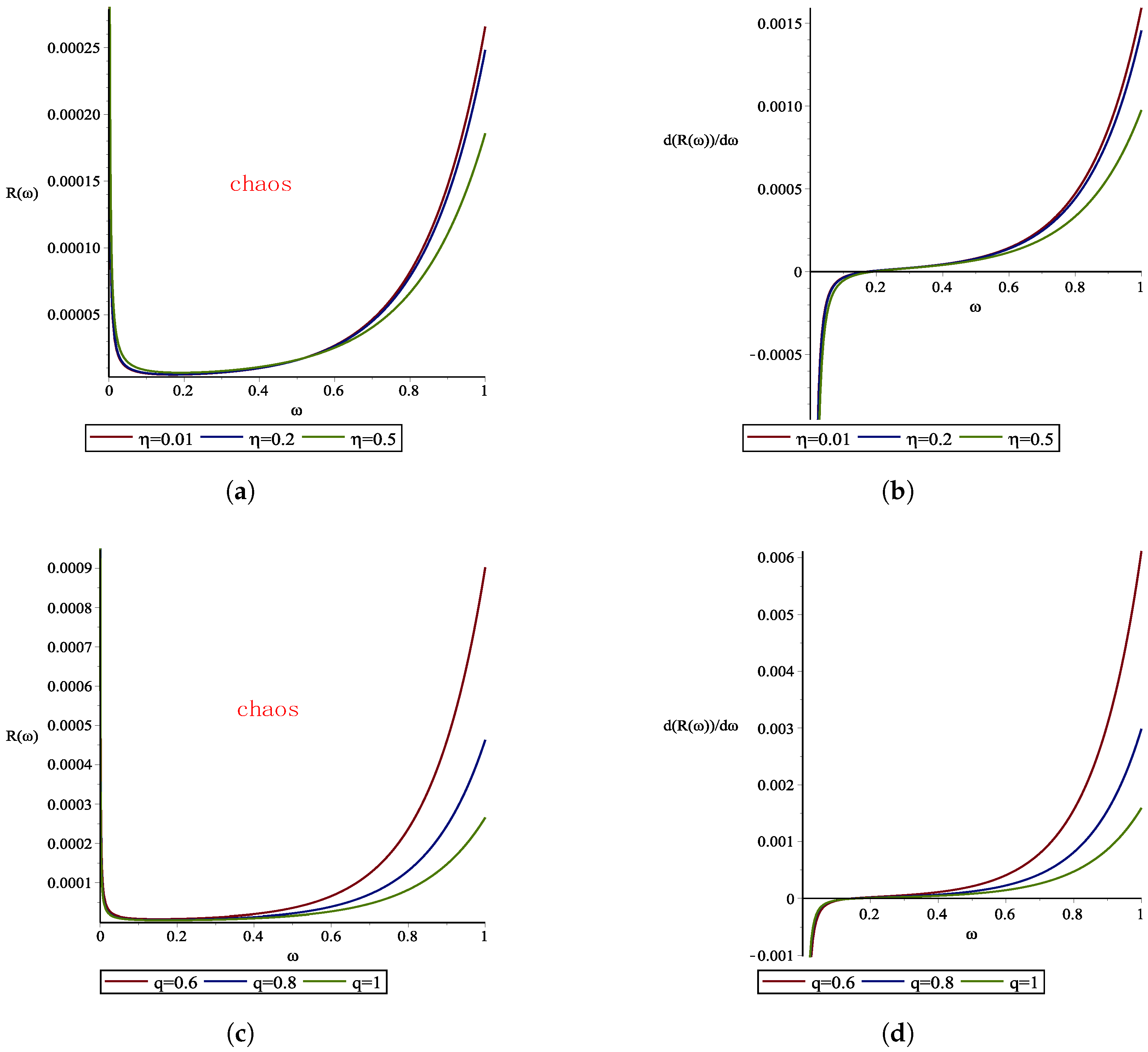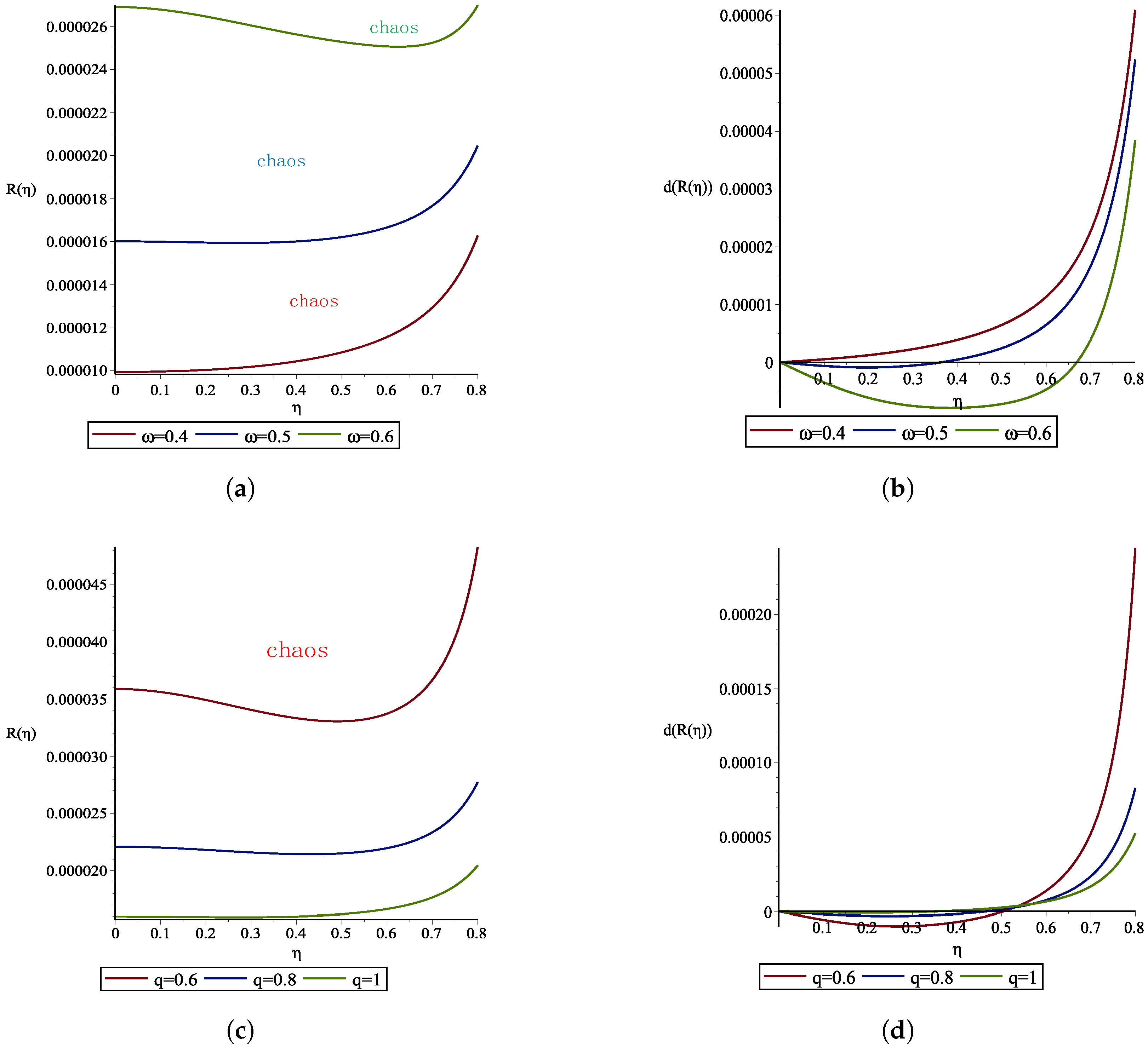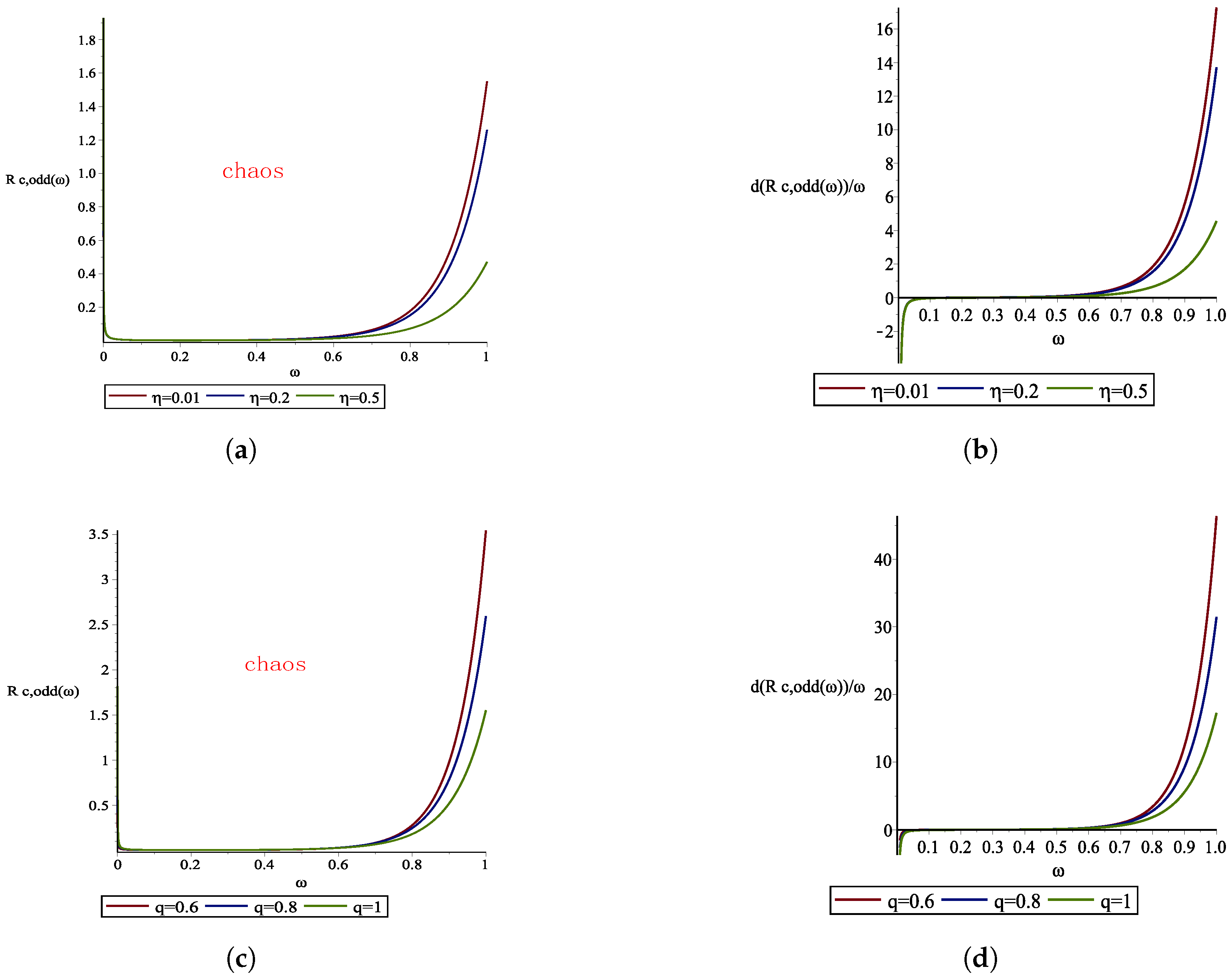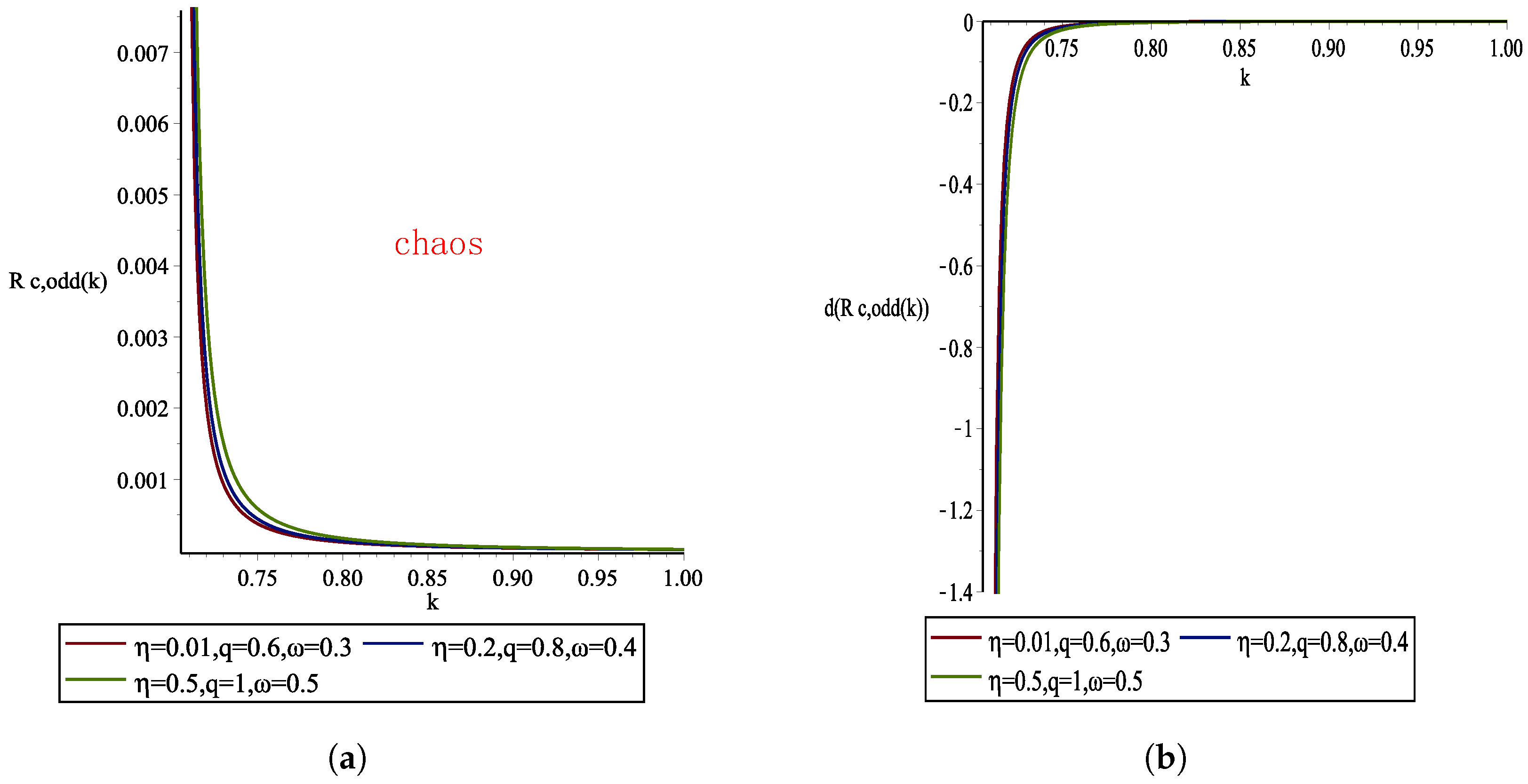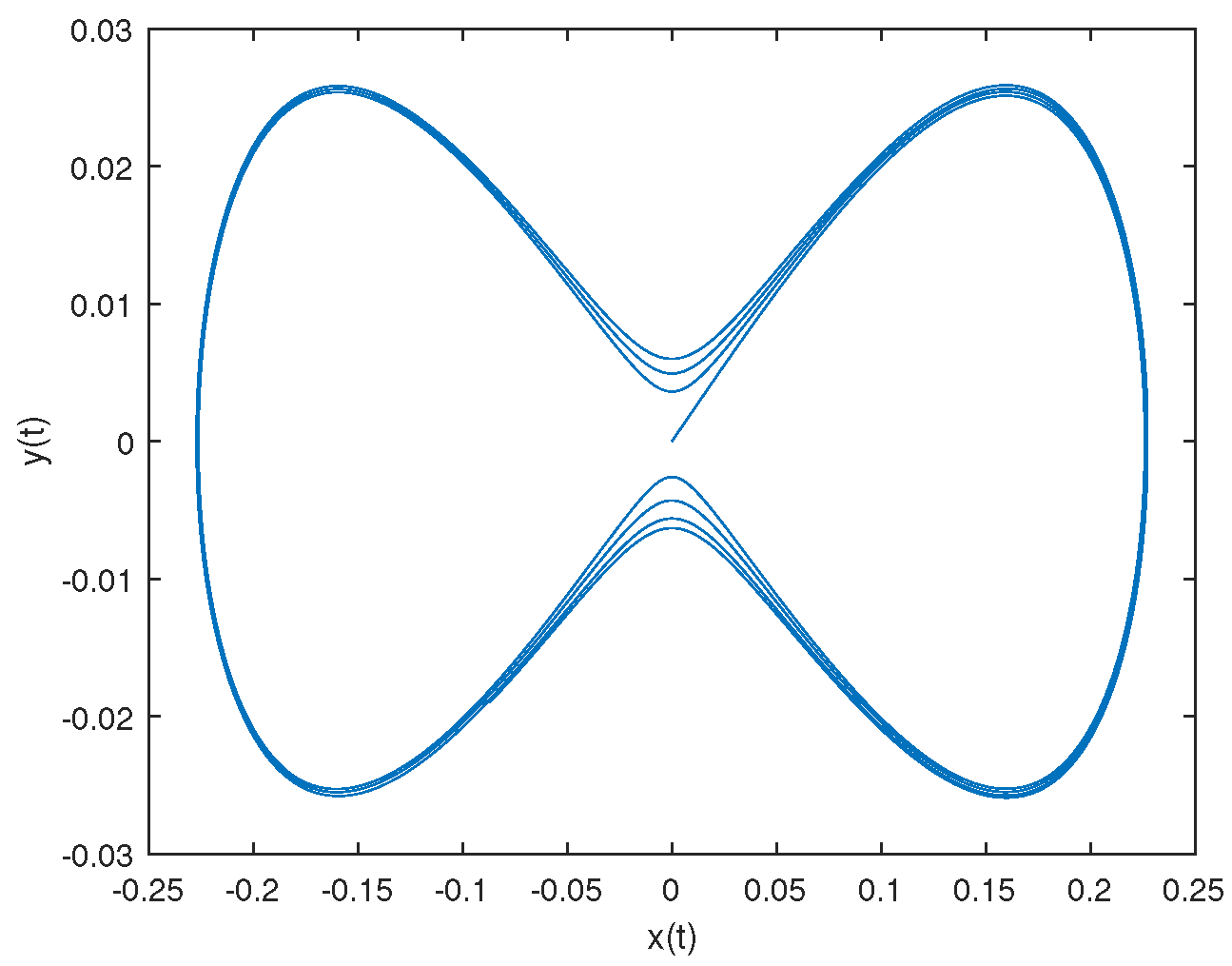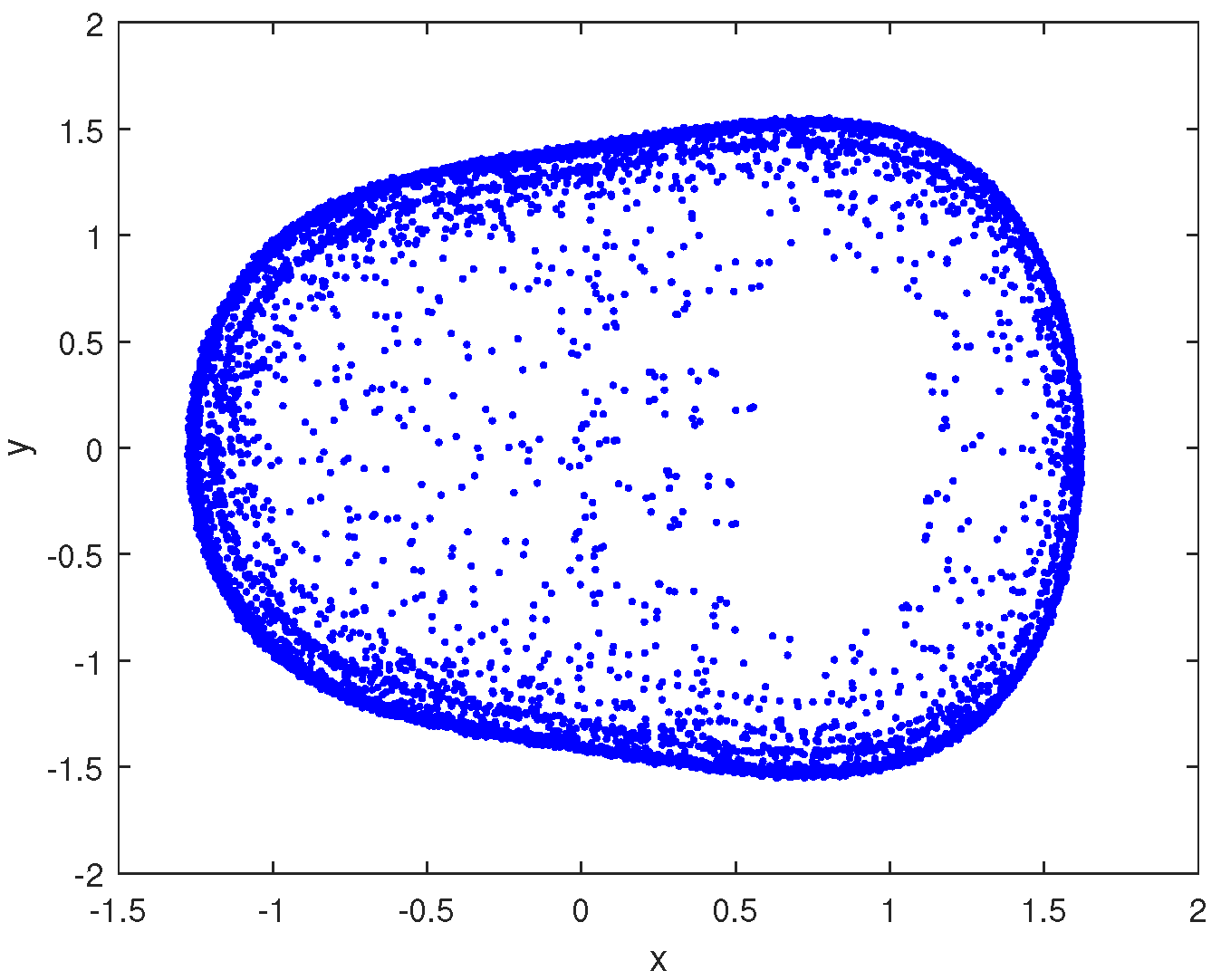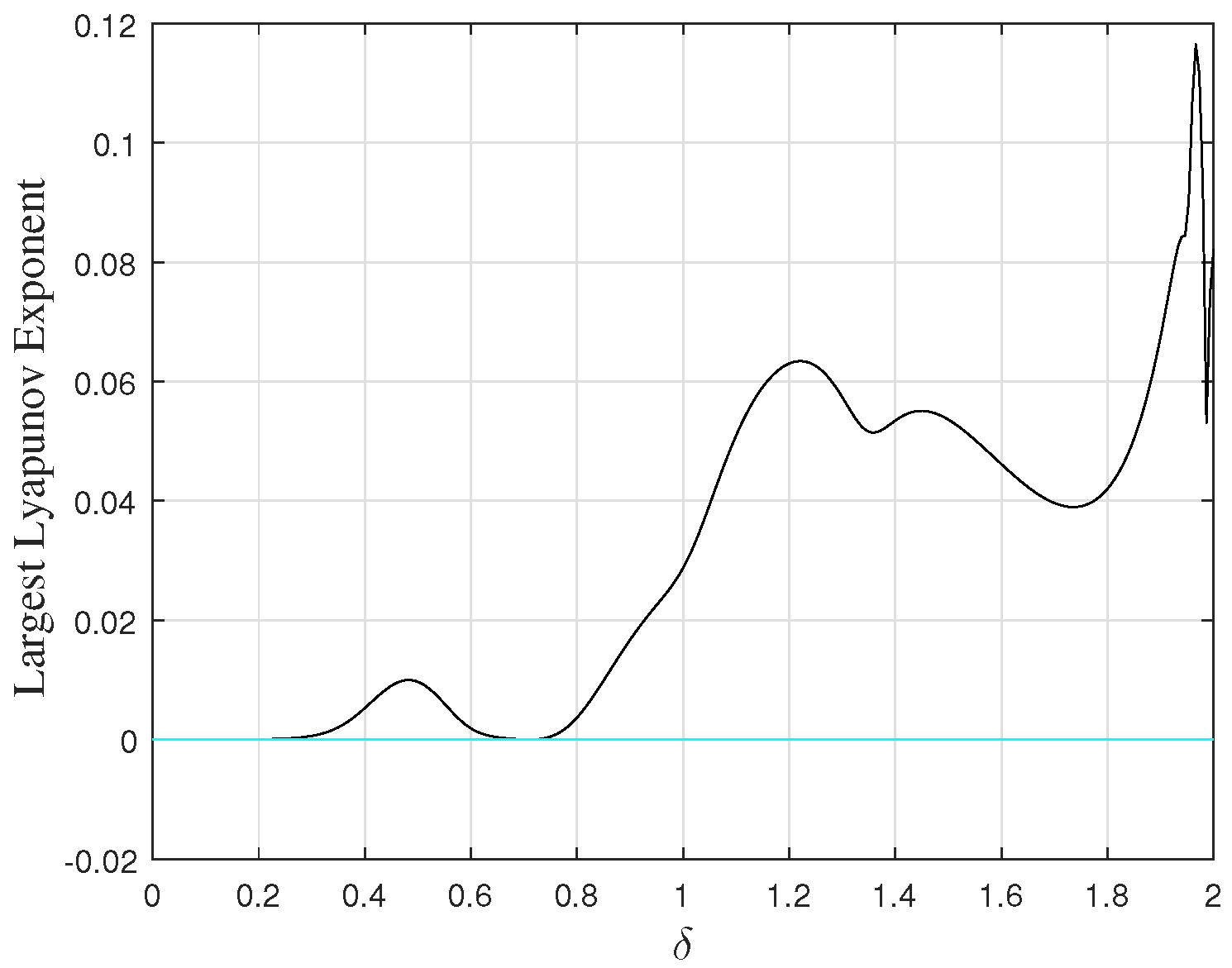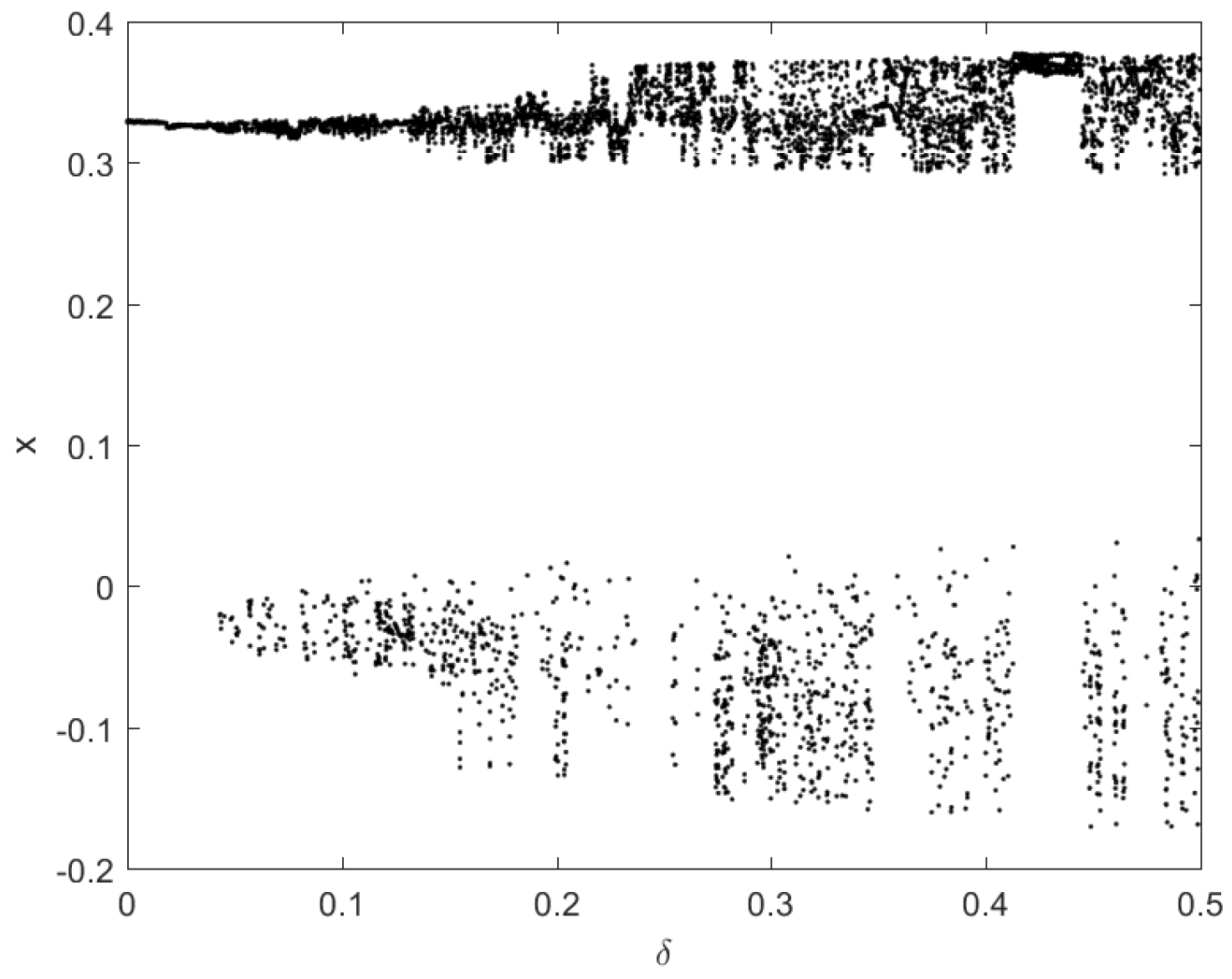1. Introduction
Black hole dynamics involves the cross-fusion of different branches of physics, such as general relativity, quantum mechanics and thermodynamics. By studying the dynamic behavior of black holes, one can promote the cross-fusion of and mutual verification between these branches of physics and explore the evolution law of the universe further. So, it is crucial to study the nonlinear dynamic characteristics of black hole systems. Some conclusions on the dynamics of black holes have been acquired in recent years.
In 1983, the stability of black holes were analyzed in asymptotic AdS-spacetime after the introduction of cosmological constants and it was found that the black hole has thermodynamic properties [
1]. Later, in Ref. [
2], it was found that chaos-bound violations in charged Bardeen black holes persist throughout spacetime while diminishing with increasing black hole charge or particle charge/angular momentum. In Ref. [
3], it was established the correspondence between the thermodynamics of black holes and van der Waals fluids by treating the cosmological constant as thermodynamic pressure. In Ref. [
4], solutions for AdS black holes with interior mixmaster chaos were derived through massive vector field couplings, reproducing BKL dynamics. In Ref. [
5], quantum-corrected AdS black holes across cosmological backgrounds were investigated and van der Waals thermodynamics with universe-dependent criticality and universal quantum-enhanced chaos featuring was shown. In Ref. [
6], the dynamics of spinning test particles around a Schwarzschild black hole with quintessence (SQBH) were investigated using the Mathisson–Papapetrou–Dixon equations. Reference [
7] studied deterministic chaos in van der Waals fluids using the Melnikov method [
8] and discussed the temporal chaos from thermal fluctuations in quenched unstable spinodal states and the spatial chaos from pressure-tuned periodic perturbations in infinite tubes.
It is natural to consider the possible chaotic behavior in black hole systems in the Melnikov context. Reference [
9] extended the method for studying the thermodynamic evolution of van der Waals fluids to the extended phase space of an RN–AdS black hole. It was shown that homogeneity/heterotopic orbital entanglements would occur in the phase space of RN–AdS black holes. The Melnikov method was used to study the critical conditions for the emergence of thermodynamic chaos. Using the Melnikov method, in Ref. [
10] the chaotic behavior of Born–Infeld–AdS black holes was investigated and it was shown the Born–Infeld parameters significantly to affect the critical conditions of thermodynamic chaos. Reference [
11] investigated the chaotic and critical behaviors in time and space of charged dilation black holes using the Melnikov method and showed that temporal chaos requires critical perturbation amplitudes to be exceeded, while spatial chaos persists unconditionally. Reference [
12] investigated the chaotic behaviors in temporal and spatial perturbations for a slowly rotating Kerr–AdS black hole based on the Melnikov method, finding that time chaos is rather to occur with an increasing angular momentum, while spatial chaos is independent of the perturbation amplitude. In Ref. [
13], chaotic timelike geodesics in disk-perturbed black hole systems were analyzed by extending the Melnikov method to 2-DOF Hamiltonian systems, demonstrating the splitting and intersection of asymptotic manifolds. Reference [
14] studied the orbital chaos induced by periodic shape oscillations in Schwarzschild spacetime through the Melnikov method, showing how prolate–oblate spheroidal deformations trigger chaotic dynamics in long-term test-body motion. Reference [
15] invetsigated charged-flat black holes in Rényi extended phase space using the Melnikov method, showing their van der Waals-like phase behavior and chaotic dynamics under thermal perturbations, which reveals the profound connections between the Rényi parameters and cosmological constant effects, and spatial perturbations universally induce chaos. Reference [
16] studied the chaotic dynamics of pulsating extended bodies in spherically symmetric spacetimes (including RN and Ayón–Beato–García black holes) through the Melnikov method, demonstrating that radial oscillations induce homoclinic intersections and consequent chaos in modified gravity scenarios. Reference [
17] investigated the chaos in charged Gauss–Bonnet AdS black holes within extended phase space using the Melnikov method, showing that temporal chaos emerges when the thermal quench parameter
surpasses a critical value dependent on the Gauss–Bonnet coupling
and charge
Q, while spatial chaos persists universally regardless of charge. Reference [
18] studied the chaotic particle motion around Schwarzschild black holes using the Melnikov method, showing that unstable circular orbits generate homoclinic trajectories which become chaotic under periodic metric perturbations. Reference [
19] investigated the spin effects of Kerr black holes on the charged particle dynamics in magnetized accretion flows, which showed that the frame-dragging induced chaos in the regularity transitions. Reference [
20] analyzed magnetized Schwarzschild chaos and demonstrated that the magnetic curvature induces neutral particle chaos while the electromagnetic forces govern the charged particle dynamics. Global dynamic behaviors also profoundly affect the properties of black holes. Therefore, we investigate here the global dynamics of black holes.
In this paper, the global dynamics, including the chaos and subharmonic bifurcation, in a dynamical model of charged expanding AdS-black holes in extended phase space is investigated using analytical and numerical methods. The monotonicity between the chaos threshold and the vibration frequency, the coupling parameters between the expansion field and the Maxwell field, and the charge of the black hole are given and proven analytically. The evolution process of the system from subharmonic bifurcation to chaos is analyzed. This demonstrates that the system can undergo chaotic motion via infinite subharmonic bifurcations of an odd order.
The paper is organized as follows. The derivation of the dynamical system is given in
Section 2. In
Section 3, the chaotic dynamics of the system is investigated.
Section 4 is devoted to the subharmonic bifurcation of this model. Numerical simulations and conclusions are given in
Section 5 and
Section 6, respectively.
2. The Dynamic Model and Problem Formulation
According to Ref. [
11], the action of Einstein–Maxwell theory with a dilation field can be expressed as
where
is the dilation field, and the electromagnetic tensor
is related to the potential vector
,
X denotes the four-vector,
g is the determinant of the metric tensor
with the indexes of Greek letters taking values 0 (time), and 1, 2, and 3 (space) coordinates,
is the Ricci scalar,
is the cosmological constant.
is the coupling parameter between the dilation and Maxwell fields, and
b is a positive constant. From Equation (
1), one obtains a solution for a spherical symmetric black hole and a metric of the form
where (
) are the spherical coordinates,
Here,
,
q is the black-hole charge, the parameter
m is associated with the ADM mass
of black hole (
2) through
, and
represents the components of electromagnetic field in the directions of
t and
r. From Equation (
2), the Hawking temperature
T and entropy
S read:
where
is the event horizon radius. Introducing the thermodynamic pressure
P, its conjugate quantity as the volume
V and the electric potential
U yields
The first law of thermodynamics and the corresponding Smarr formula in extended phase space are then expressed as
respectively.
Based on Equations (
5) and (
6), the thermodynamic pressure
P then reads
where
is the specific volume.
According to Refs. [
17,
21], one can assume that the flow of the charged dilation-AdS black hole moves along the
x-axis of a fixed-volume unit cross-section. Then, using Eulerian coordinates to describe the mass of the column of fluid of the unit cross-section between points
x and
yields
Note that
M in Equations (
7) and (
9) is not the same parameter. From the definition of
M, one can deduce that
x can be phrased as
, and
defines the velocity (where the dot on the top denotes the time-derivative). Then,
is defined as the specific volume
. According to these equations and Ref. [
21], one can deduce that the flow of the charged dilation-Ads black hole can be described using a dynamical system with a balance equation for the mass and the momentum, i.e.,
where
is the Piola stress. It can be deduced that the black hole system is thermoelastic, isotropic and slightly viscous [
11,
21]; thus,
reads
Here and in what follows, the variables in the subscript denote the derivatives, such as
,
,
etc.
A is a positive coefficient, and
is a relatively small positive constant viscosity. Substituting Equation (
10) into Equation (
11) and introducing the transformation
, and
, where
is a perturbation parameter and
is the proper viscosity, Equation (
11) can be rewritten as follows:
where
. Here, the hats are omitted for brevity.
Similar to that in Ref. [
11], the values of the positive parameters are fixed, the system pressure
P changes with temperature
T and specific volume
, and there exists a critical temperature
in the system. Specifically, when
, the system is considered to undergo a black hole phase transition with a change in
:
corresponds to a relatively small black hole phase,
is a large enough black hole phase, and
corresponds to a region in which such small–large black hole phases coexist. The chaotic phenomena in the system under the coexistence of those large and small black holes is studied in the Sections to follow. According to Ref. [
7], taking
and
, the absolute temperature close to
can be expressed as
with small time-periodic fluctuations, where
is the frequency and
is the disturbance amplitude. To perform a perturbation analysis, we expand Equation (
8) of
into a Taylor series. Then, we set
where
and
,
, and
equal zero because Equation (
8) contains only the first term of
T,
As soon as
,
and
can be Fourier-expanded in the vicinity of
:
where
and
are the parameters of the hydrodynamical model which describes the deviation from the initial equilibrium state with
. In this paper, we consider only the first mode (
) and, for brevity, omit the subscript.
With these conditions, Equation (
12) reads:
where
,
,
, and
are
,
,
, and
, respectively. Since
, Equation (
16) can be rewritten in the following form:
In terms of
and
, Equation (
17) reads
4. Chaotic Motion in the System
The chaotic phenomena in dynamic systems can be studied analytically using the Melnikov method. The method is commonly used in various areas, such as for an extended Duffing–van der Pol oscillator with a nonlinear quintic term [
22], a symmetric gyro-subjected system [
23], the oscillatory nonlinear dynamic system of a turbine rotor [
24], a conveyor belt system featuring bilateral rigid restraints interconnected via inclined springs and dampening elements [
25], a cantilever beam that is supported by obliquely positioned springs and subjected to bilateral asymmetric rigid constraints [
26], a Rayleigh–Duffing oscillator subjected to both non-smooth periodic perturbations and harmonic excitation [
27], spherical shells with incompressible hyperelastic properties [
28], a bistable piezoelectric energy harvester [
29] etc. As so, also in this paper, the chaotic motion of the system (
17) is studied using the Melnikov method.
4.1. Melnikov Analysis and Thresholds for Chaotic Systems
Calculating the Melnikov function for the given system (
17) along the homoclinic paths
for which, using the residue theorem and function transformation, one obtains the integrals
Thus,
has simple zeros if
4.2. The Chaotic Threshold of the System
Now, let us analyze this system’s chaotic threshold value with certain parameters based on Ref. [
11], fixing the system’s constant coefficients to
, taking the proper viscosity
, and setting the perturbation
. Equation (
25) can be rewritten as follows:
R is the chaotic threshold which is related only to , q (via ), and . The influence of the other parameters on R is discussed by fixing the values of two to achieve the purpose of controlling the chaos threshold, and the following three cases are discussed as follows. Taking q close to 1, the system represents an ideal black hole whose physical properties can be fully determined using the aforementioned parameters. Taking as a small enough valuethe influence of the dilation field on the electromagnetic field becomes relatively weak, and the electromagnetic radiation of the black hole follows rather standard thermodynamic laws. We choose quite a small value for to ensure the periodicity of the perturbations. All the parameters are set to the values given just above.
4.2.1. Case 1: Fixed and q
Figure 2 shows the curve of the chaotic threshold
(
26) and the change in the chaotic threshold rate
with the frequency
using the parameters defined just above for different values of
and
q. One can see that the shape of and trend in the curve are nearly the same, what indicates that proper adjustment of the values of
and
q do not change the direction of the chaotic threshold
. Therefore, it is reasonable and complete to discuss the characteristics of the chaotic threshold when
and
. (Specifically,
and
can be determined based on these values).
Conclusion 1. For and , the chaotic threshold decreases monotonically as increases for and, conversely, the threshold increases monotonically with for .
4.2.2. Case 2: Fixed and q
Figure 3 shows the curve in the chaotic threshold
(
26) and the change in the chaotic threshold rate
as a function of
for different values for
and
q using the above-defined parameters. As due to Conclusion 1 of
Section 4.2.1, the change in the values of
q and
has little effect on the trend in the chaotic threshold
. Therefore, it is reasonable and complete to discuss the characteristics of the chaotic threshold when
and
.
Conclusion 2. For and , the chaotic threshold decreases monotonically as increases for and, conversely, the threshold increases monotonically with for .
4.2.3. Case 3: Fixed and
The curve of the chaotic threshold
and the change in the chaotic threshold rate
with
q for different values of
and
using the parameters defined above are shown in
Figure 4. As due to Conclusion 1 of
Section 4.2.1, the change in the values of
q and
has little effect on the trend in the chaotic threshold
. Therefore, it is reasonable and complete to discuss the characteristics of the chaotic threshold when
.
Conclusion 3. For and , the chaotic threshold increases monotonically as q increases for and, conversely, the threshold decreases monotonically with increasing for .
